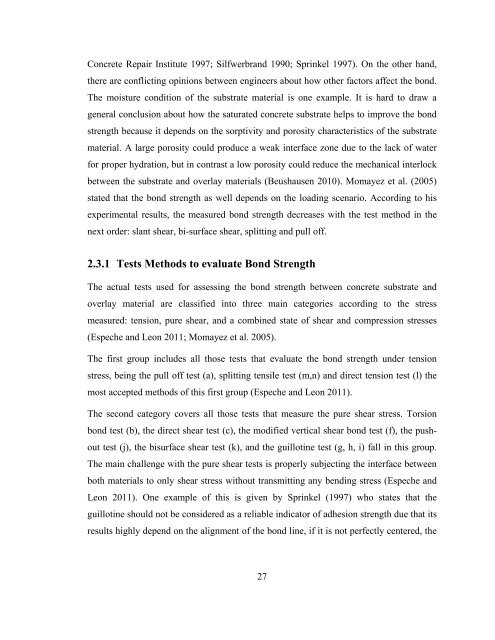compatibility of ultra high performance concrete as repair material
compatibility of ultra high performance concrete as repair material
compatibility of ultra high performance concrete as repair material
You also want an ePaper? Increase the reach of your titles
YUMPU automatically turns print PDFs into web optimized ePapers that Google loves.
Concrete Repair Institute 1997; Silfwerbrand 1990; Sprinkel 1997). On the other hand,there are conflicting opinions between engineers about how other factors affect the bond.The moisture condition <strong>of</strong> the substrate <strong>material</strong> is one example. It is hard to draw ageneral conclusion about how the saturated <strong>concrete</strong> substrate helps to improve the bondstrength because it depends on the sorptivity and porosity characteristics <strong>of</strong> the substrate<strong>material</strong>. A large porosity could produce a weak interface zone due to the lack <strong>of</strong> waterfor proper hydration, but in contr<strong>as</strong>t a low porosity could reduce the mechanical interlockbetween the substrate and overlay <strong>material</strong>s (Beushausen 2010). Momayez et al. (2005)stated that the bond strength <strong>as</strong> well depends on the loading scenario. According to hisexperimental results, the me<strong>as</strong>ured bond strength decre<strong>as</strong>es with the test method in thenext order: slant shear, bi-surface shear, splitting and pull <strong>of</strong>f.2.3.1 Tests Methods to evaluate Bond StrengthThe actual tests used for <strong>as</strong>sessing the bond strength between <strong>concrete</strong> substrate andoverlay <strong>material</strong> are cl<strong>as</strong>sified into three main categories according to the stressme<strong>as</strong>ured: tension, pure shear, and a combined state <strong>of</strong> shear and compression stresses(Espeche and Leon 2011; Momayez et al. 2005).The first group includes all those tests that evaluate the bond strength under tensionstress, being the pull <strong>of</strong>f test (a), splitting tensile test (m,n) and direct tension test (l) themost accepted methods <strong>of</strong> this first group (Espeche and Leon 2011).The second category covers all those tests that me<strong>as</strong>ure the pure shear stress. Torsionbond test (b), the direct shear test (c), the modified vertical shear bond test (f), the pushouttest (j), the bisurface shear test (k), and the guillotine test (g, h, i) fall in this group.The main challenge with the pure shear tests is properly subjecting the interface betweenboth <strong>material</strong>s to only shear stress without transmitting any bending stress (Espeche andLeon 2011). One example <strong>of</strong> this is given by Sprinkel (1997) who states that theguillotine should not be considered <strong>as</strong> a reliable indicator <strong>of</strong> adhesion strength due that itsresults <strong>high</strong>ly depend on the alignment <strong>of</strong> the bond line, if it is not perfectly centered, the27
















